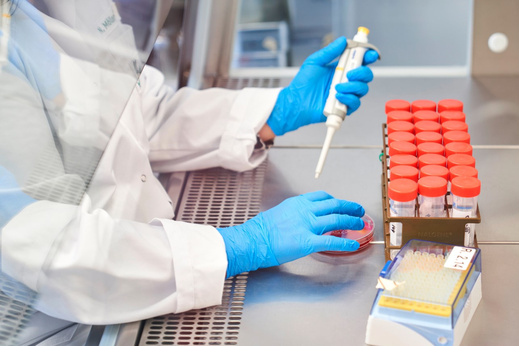Active Medical Devices
Medical devices are initially divided into active (operation directly dependent on an energy source, e.g. electricity) and non-active medical devices. Active medical products or other medical devices can be used to manufacture or reprocess medical products themselves or for use in diagnostics or therapy on humans.
The experts of HygCen Germany support you in securing the reprocessing of medical devices, among other things, from:
The safety of the overall processes can only be guaranteed under the precondition of the safety of the sub-processes (“from patient to patient”).
The essential process steps of cleaning and disinfection must therefore be characterized qualitatively and quantitatively and analyzed with all other steps of the entire reprocessing process in their mutual dependency.
| Device | Validation of the processes according to the standard | Type testing of the device according to the standard |
|---|---|---|
| Washer-disinfector | EN ISO 15883-2, -3, -4, -6, -7 | EN ISO 15883-1, -2 and others of the series of standards |
| Drying cabinets for endoscopes | EN 16442 | EN 16442 |
| Sealing machines | EN ISO 11607-2 | EN ISO 11607-2 |
| Small sterilizers | EN ISO 17665-1 | EN 13060 |
| Steam sterilizers | EN ISO 17665-1 | EN ISO 285 |
| EO sterilizers | EN ISO 11135 | EN ISO 11135 / EN 1422 |
| Formaldehyde sterilizers | EN 14180 | EN ISO 25424 |
| H2O2-/plasma sterilizers | EN ISO 14937 | EN ISO 14937 |
As a patient, you have the right to ensure that there is no risk of infection or colonization with pathogens when using a medical device even after reprocessing.
This requirement applies to the first as well as to the 100th reprocessing cycle of medical devices, for example.
The increasing centralization of the reprocessing of medical products in the last few decades has increased the overall process reliability for the patient. Nevertheless, if reprocessing processes are not demonstrably carried out safely, there is also the risk of endangering not only individual patients but also a large number of patients.
Legal requirements in Germany
In Europe, the handling of medical devices is regulated in the national medical device laws (MPG) and on the basis of the European Medical Device Regulation (MDR). The Medical Device Operator Ordinance (MPBetreibV) was also created in Germany on the basis of the MPG. In Section 4, Paragraph 1, this clearly stipulates that medical devices can only be reprocessed using suitable, validated procedures.
What are suitable validated preparation processes?
Validation is a documented procedure for producing, recording and interpreting the results that are required to prove that a certain procedure or a certain process consistently (reproducibly) delivers products that correspond to the specified specifications (specific product standards).
A validation is therefore the documented proof of the constant efficacy of a reprocessing process. Each reprocessing should therefore only be carried out using validated processes.
When commissioning a device for reprocessing medical products, the operator must initiate the initial validation of the reprocessing processes. This consists of:
In general, the stability of the process must be guaranteed in terms of process technology. I.e. A validated process only exists as long as there are no changes that could influence the process flow (e.g. process changes, technical defects, change in chemical agents, etc.).
In some states, the authorities set the “revalidation interval” or the period up to renewed performance qualification (PQ) at a maximum of one year.
We offer you the validation of all technical reprocessing processes in cleaning / disinfection devices, heat sealing devices and sterilization devices (steam, plasma / H2O2, low temperature steam and formaldehyde (LTSF) and ethylene oxide (EO) processes).
In addition, the other sub-steps of the medical device cycle, from use on the patient to reuse, can also be checked (pre-cleaning, packaging, transport / logistics, storage, disposal).
Not every design guarantees permanent process stability in a comprehensible way, especially with process risks that occur in everyday life.
In Europe, the term “type test” was coined. Such tests provide evidence that a device meets the requirements of the relevant product standards and is therefore suitable for the intended area of application. Therefore, only type-tested devices should be considered for new acquisitions and tenders; so e.g. In the case of cleaning / disinfection devices for endoscopes, only type-tested devices according to EN ISO 15883, the processes of which must then be validated according to the same EN ISO series of standards. In contrast to validation, a device or a machine is tested for general suitability during a type test, while during a validation of the individual specific processes, their safety is checked.
Both the validation of the processes and the type testing of the devices should be carried out by accredited laboratories.
Accredited test laboratories are manufacturer-independent and are regularly checked for their qualifications by state accreditation bodies (ZLG and DAkkS). This guarantees the user / operator and the patient the highest level of safety.
Using type-tested devices with validated processes by manufacturer-independent, accredited test laboratories and taking into account the entire medical device cycle, medical devices can be reprocessed in a responsible manner in accordance with the state of the art in terms of patient care.
The EN ISO 15883 series specifies requirements for washer-disinfectors for medical devices, including test methods for effectiveness and safety.
It applies to active medical devices such as washer-disinfectors used in hospitals, laboratories, and clinics.
It ensures devices meet cleaning and disinfection performance, comply with regulations, and guarantee patient safety.
The series includes multiple parts, covering devices for surgical instruments, endoscopes, and other medical products.
Our accredited laboratories conduct standardized tests according to EN ISO 15883 and provide a detailed report for your product approval.
You will receive a digital test report including a professional assessment, secured with a Qualified Electronic Signature (QES). This guarantees the legal validity, integrity, and immutability of your documents – recognized across the world.



